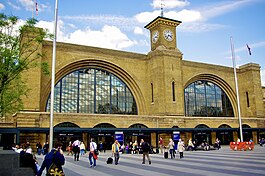
Back محطة كينغز كروس Arabic محطة كينجز كروس ARZ Кингс Крос Bulgarian লন্ডন কিংস ক্রস রেলওয়ে স্টেশন Bengali/Bangla Porzh-houarn King's Cross Breton King's Cross Catalan وێستگەی کینگز کرۆس CKB Nádraží King's Cross Czech Gorsaf reilffordd King's Cross Llundain Welsh King's Cross Station Danish
| King's Cross | |
|---|---|
| London King's Cross | |
 King's Cross station frontage following restoration, in 2014 | |
| Location | King's Cross |
| Local authority | London Borough of Camden |
| Managed by | Network Rail |
| Owner | Network Rail |
| Station code | KGX |
| DfT category | A |
| Number of platforms | 11 (numbered 0–10) |
| Accessible | Yes |
| Fare zone | 1 |
| OSI | King's Cross St Pancras London St Pancras London Euston |
| Cycle parking | Yes – platforms 0 & 1, 8, 9 and car park racks |
| Toilet facilities | Yes |
| National Rail annual entry and exit | |
| 2018–19 | |
| – interchange | |
| 2019–20 | |
| – interchange | |
| 2020–21 | |
| – interchange | |
| 2021–22 | |
| – interchange | |
| 2022–23 | |
| – interchange | |
| Railway companies | |
| Original company | Great Northern Railway |
| Pre-grouping | Great Northern Railway |
| Post-grouping | London and North Eastern Railway |
| Key dates | |
| 14 October 1852 | Opened |
| Other information | |
| External links | |
| Coordinates | 51°31′51″N 0°07′24″W / 51.5309°N 0.1233°W |
King's Cross railway station, also known as London King's Cross, is a passenger railway terminus in the London Borough of Camden, on the edge of Central London. It is in the London station group, one of the busiest stations in the United Kingdom and the southern terminus of the East Coast Main Line to Yorkshire and the Humber, North East England and Scotland. Adjacent to King's Cross station is St Pancras International, the London terminus for Eurostar services to continental Europe. Beneath both main line stations is King's Cross St Pancras tube station on the London Underground; combined, they form one of the country's largest and busiest transport hubs.
The station was opened in Kings Cross in 1852 by the Great Northern Railway on the northern edge of Central London to accommodate the East Coast Main Line. It quickly grew to cater to suburban lines and was expanded several times in the 19th century. As part of the Big Four grouping in 1923, it came under the ownership of the London and North Eastern Railway, who introduced famous services such as the Flying Scotsman and locomotives such as Mallard. The station complex was redeveloped in the 1970s, simplifying the layout and providing electric suburban services, and it became a major terminus for the high-speed InterCity 125. As of 2018[update], long-distance trains from King's Cross are run by London North Eastern Railway to Edinburgh Waverley, Leeds and Newcastle; other long-distance operators include Hull Trains and Grand Central. In addition, Great Northern runs suburban commuter trains around North London, Hertfordshire, Cambridgeshire and Norfolk.
In the late 20th century, the area around the station became known for its seedy and downmarket character, and was used as a backdrop for several films as a result. A major redevelopment was undertaken in the 21st century, including restoration of the original roof, and the station became well known for its association with the Harry Potter books and films, particularly the fictional Platform 9+3⁄4.
- ^ "Out of Station Interchanges" (XLSX). Transport for London. 16 June 2020. Retrieved 5 November 2020.
- ^ a b c d e f g h i j "Estimates of station usage". Rail statistics. Office of Rail Regulation. Please note: Some methodology may vary year on year.
© MMXXIII Rich X Search. We shall prevail. All rights reserved. Rich X Search
